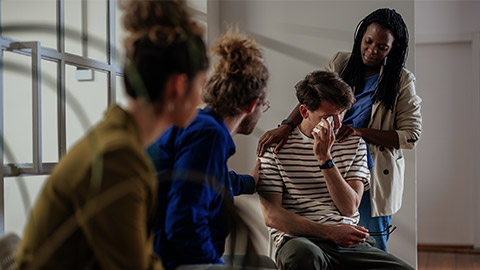This topic provides insight into various prevention and intervention techniques.
When working in the AOD space, you will come across different types of people. To support the individual in their process and journey, you will need to understand a variety of preventions and interventions that you can use to help the individual.

A relapse occurs when the person returns to their previous level of using alcohol or other drugs. This is different from a lapse, which is a temporary return to using the substance(s), for example, having a single glass of alcohol and then continuing with abstaining.
Many different factors contribute to relapsing, including:
- Situations that led to the drug or alcohol use in the first place
- Situations that remind or trigger the person to use again
- Feelings of guilt and failure following a lapse
- Underlying physical or mental health issues.
Lapses and relapses are expected, as recovery can take many attempts. Strategies for dealing with them should be built into the person’s treatment plan. Maintaining a positive attitude and supporting belief in the possibility of recovery is essential.
In the short term, it may be necessary to seek medical support, for example, if there is a risk of overdose. It is important to reassure the person that a single lapse—or even relapse and a return to former levels of use—does not mean total failure, and it is possible to overcome the temptation to relapse. Relapse can be seen as a learning opportunity.
Tip
You might find that you do not often come across the term ‘lapse’ in your workplace. Among people dealing with alcohol and other drug issues, it is expected to prefer the term ‘relapse’, as the amount is not relevant to these individuals. To call it a ‘lapse’ can often be seen as minimising or justifying the behaviour/action.
Strategies for preventing relapse can include:
- Avoiding places, people or situations where relapse is likely
- Seeking help and support and building support networks to call upon when needed
- Maintaining a healthy lifestyle
- Developing good self-care strategies and routines
- Engaging in meaningful activities
- Working to change thoughts and perspectives that lead to using
- Using, if necessary, medications such as anti-depressants.
Reading
- Read this article for an introduction to preventing relapse: Relapse.ADF.
- Read this article for more in-depth information about relapse and strategies to prevent it: What is Relapse Prevention.
- Read this article for detailed information about developing effective relapse prevention plans: How to Create a Successful Relapse Prevention Plan.
Case Study

Anticipating and Preventing Relapse
Sophia is the CEO of an accounting firm. She attends business dinners and social events and is sometimes called on to give a speech. She has always been shy, and public speaking is one of her greatest fears.
As a young woman, Sophia began to use alcohol to help her overcome her shyness. She became dependent on alcohol to the point where she was drinking at work to help her get over her nerves when presenting information at an event or conference or to a group of colleagues.
Sophia realised her consumption of alcohol was affecting her health, so she joined an Alcoholics Anonymous (AA) group. She is also attending regular counselling sessions and has not had a drink of alcohol for several months.
Next week, Sophia is due to present awards at an industry association meeting. She is afraid that she will give in to temptation and drink before this event. She discusses this with her counsellor, and they agree that Sophia will ask her GP to prescribe a mild tranquiliser for her to take before the event so she will be less tempted to take a drink.
Her counsellor also teaches her a meditation technique that she can use to calm herself on the night.

The term ‘crisis’ is generally used to mean a state in which the person is unable to function in their usual way, often due to a significantly stressful event. Crisis events cause emotional, psychological and physical distress and affect the person’s behaviour and ability to function. In the context of AOD, a crisis can trigger a relapse.
A crisis is triggered by an event or situation that the person finds overwhelming and seeks help to deal with. Crisis interventions usually consist of short-term immediate help.
The American psychiatrist Gerard Caplan defines a crisis as ‘occurring when a person faces an obstacle to important life goals that is, for a time, insurmountable by customary means of problem-solving’.
A crisis is seen as presenting both threats to opportunities for personal growth.
During a crisis, the way people communicate changes.
People process information differently and often revert to ‘flight-or-fight’ reasoning. Their responses may be exaggerated, and their perceptions become distorted.
- Important or complex information may be missed, and messages may be misinterpreted.
- People tend to fall back on existing beliefs and find it hard to absorb new information.
- People tend to believe the first message and to fill in the blanks with speculation when there is not enough information.
- Emotions experienced in a crisis include fear, anxiety, dread, and feelings of despair and powerlessness.
- Denial is common, and people find it hard to believe the threat or danger.
- Panic may result from the ‘fight-or-flight’ response to extreme stress.
Crisis interventions are short-term interventions that address the person’s immediate, urgent needs. Keeping everyone involved as safe as possible is the guiding principle. In the context of AOD services, experiencing a crisis may lead the person to self-harm, attempt suicide, or harm others. This means that safety is a paramount concern.
Reading
- Visit this link to learn more about crisis intervention: Crisis Intervention.
- Read the information at the link below, and watch the video included to learn more about crisis management in AOD settings: Navigating a crisis: Conversations of change.
- This resource provides useful guidelines for responding to crisis situations, including steps for assessing and responding to risks: Crisis Referral Tool for AOD Services by the Mental Health Commission (WA) and the Western Australian Network of Alcohol & Other Drug Agencies.

A brief intervention is precisely that: a brief (around five minutes). It means taking an opportunity to assess a person’s alcohol and/or drug use and their risk of becoming dependent or addicted and to raise their awareness of these risks.
The World Health Organization (WHO) defines brief interventions as ‘practices that aim to identify a real or potential alcohol (or other drug) problem and motivate an individual to do something about it’. They include screening and assessment, which then allows the clinician to provide information and advice to reduce risky alcohol or other drug consumption and related problems. They are generally opportunistic and are offered to people who have not sought treatment or assistance but have been identified through routine screening.
Brief interventions aim to inform people that they are drinking or using drugs at levels that increase their risk of developing abuse or dependence disorders and to encourage them to decrease consumption to reduce risk.
Craig Rodgers, ‘Brief Interventions for Alcohol and Other Drug Use’
Brief interventions aim to prevent alcohol and drug use from becoming a dependency or an addiction, so they are essentially preventive measures.
FLAGS and the 5 As
FLAGS and the 5 As are two tools that provide a framework for conducting a brief intervention to support a client in changing their alcohol- and/or drug-use behaviour.
The FLAGS steps in brief interventions are:
| Feedback | Give feedback to your client about risks and issues associated with AOD. |
|---|---|
| Listen | Listen to your client’s response and discuss their consumption compared to that of the general population. |
| Advice | Provide clear advice about how important it is that they change their AOD-use behaviour. |
| Goals | Discuss safe drinking limits and help your client to set clear, measurable goals using positive language. |
| Strategies | Help your client to identify and commit to strategies that will help them to attain their goals. It is important for the client to have control over the choice of goals and strategies. |
The 5 As are:
- Ask
- Assess
- Advise and agree
- Assist
- Arrange
Ask your client about their behaviour to identify risk factors.
Assess your client’s level of risk, their readiness to change and their understanding of healthy behaviour.
Give your client written information about motivational interviewing and advise on its aims and process. Negotiate and agree to goals.
Work with your client to develop a risk management plan, including lifestyle education, to meet their individual needs.
Refer the client to allied health services, counselling and community support. Follow up and monitor to prevent relapse.
Reading
- Read the information for more detailed information on FLAGS and the 5 A’s: Brief interventions for alcohol and other drug use.
- Read the information at the link below for a more detailed discussion of brief interventions in AOD: Brief Interventions and Brief Therapies for Substance Abuse.
- Explore this link to find a range of resources for supporting brief interventions: ‘Brief Interventions: Tools and Resources to Conduct an AOD Brief Intervention’ from Insight.
Watch
Watch this video illustrating a brief intervention.
‘Protective intervention’ is a term used more commonly in the context of child protection. It means taking action to protect a person (e.g. a child) who is vulnerable and at risk of harm.
In the context of AOD services, you might be required to act to protect a client from harm, for example, a person who is intoxicated to the extent of being a risk to themselves and others. This can be tricky, as it may involve restraining the person in some way; or arranging an involuntary admission to a hospital, residential AOD treatment program or other place of safety.
Case Study

Grief-Induced Relapse
John works as a counsellor in an AOD program. Inga is one of his clients. She is in her late twenties,works in hospitality and lives in a small flat in an inner-city area. Inga enjoys visiting nightclubs, dancing and socialising with friends.
Inga has been drinking heavily since her early teens and has been diagnosed with moderate liver damage. She has joined an AA group and is participating in a CBT program with John.
Last week, Inga’s best friend, Lisa, died in a road traficc crash. Inga is finding this loss very hard to cope with and she has started binge drinking again. She arrives at John’s office intoxicated and tells him she has been drinking vodka with a friend. She is slurring her words, is unsteady on her feet and, while she is sitting talking to John, slips in and out of consciousness.
John is concerned about the amount of vodka Inga has consumed and is also wondering if she might have taken some other drug. When she slips off her chair onto the floor and starts breathing noisily, John calls Triple Zero (000).
While he is waiting for the ambulance to arrive, he places Inga in the recovery position, checks that her airways are clear and covers her with a throw rug. He calls his supervisor in and explains the situation to her.
When the ambulance arrives, the paramedics assess Inga as being comatose and take her to the emergency department at a local hospital.
